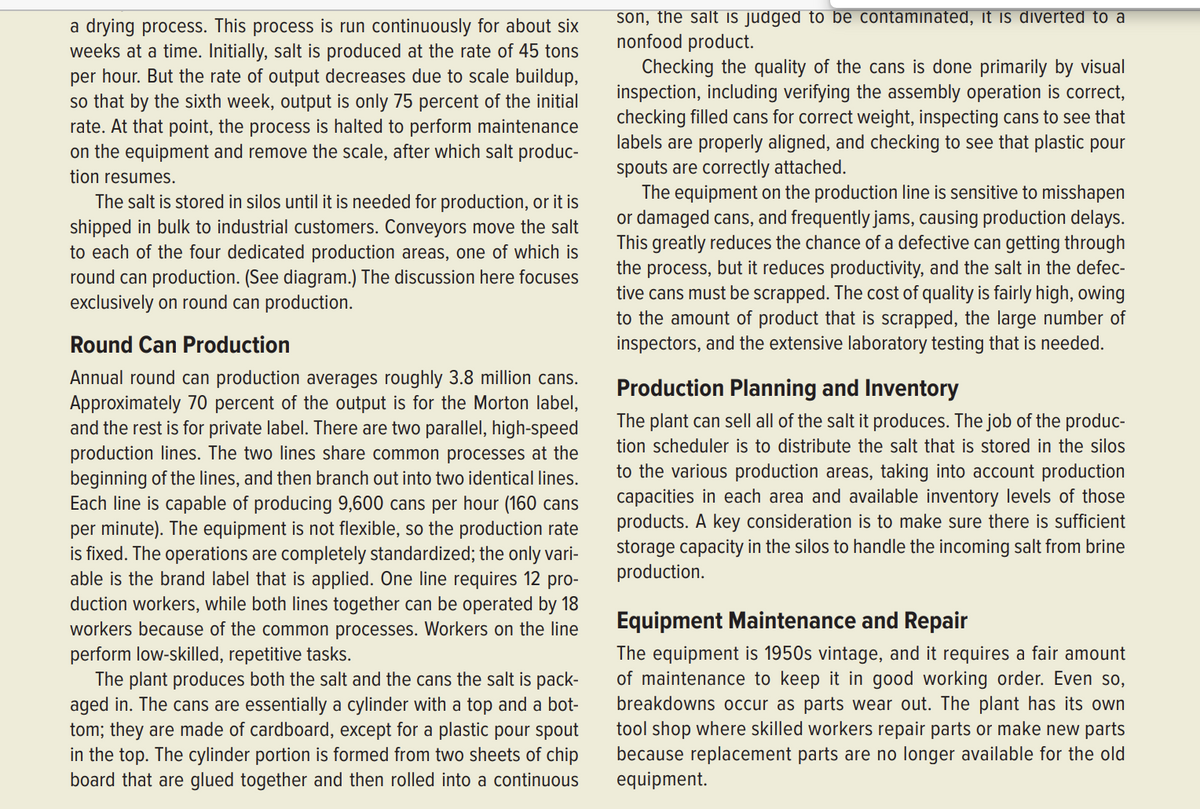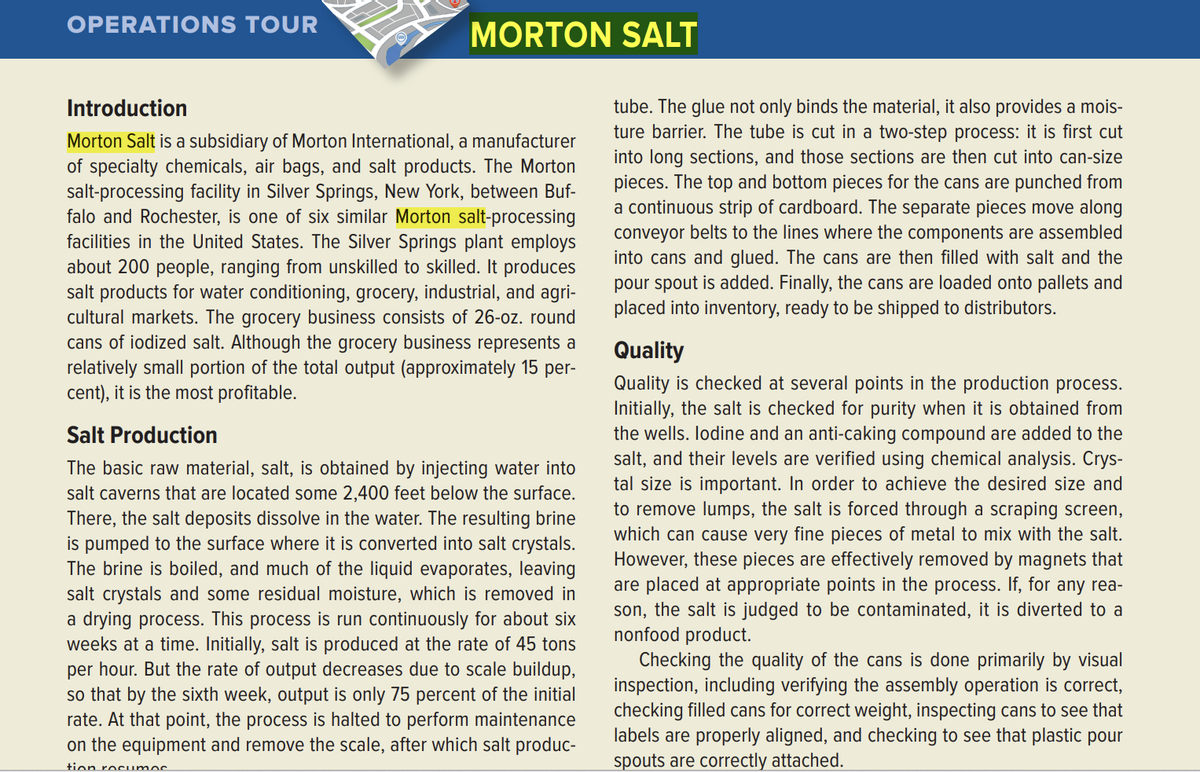Question: Where would you place salt production in the product-process spectrum? Please explain.
Question: Where would you place salt production in the product-process spectrum? Please explain.
Practical Management Science
6th Edition
ISBN:9781337406659
Author:WINSTON, Wayne L.
Publisher:WINSTON, Wayne L.
Chapter2: Introduction To Spreadsheet Modeling
Section: Chapter Questions
Problem 20P: Julie James is opening a lemonade stand. She believes the fixed cost per week of running the stand...
Related questions
Question
Question: Where would you place salt production in the product-process spectrum? Please explain.

Transcribed Image Text:a drying process. This process is run continuously for about six
weeks at a time. Initially, salt is produced at the rate of 45 tons
per hour. But the rate of output decreases due to scale buildup,
so that by the sixth week, output is only 75 percent of the initial
rate. At that point, the process is halted to perform maintenance
on the equipment and remove the scale, after which salt produc-
son, the salt is judged to be contaminated, it is diverted to a
nonfood product.
Checking the quality of the cans is done primarily by visual
inspection, including verifying the assembly operation is correct,
checking filled cans for correct weight, inspecting cans to see that
labels are properly aligned, and checking to see that plastic pour
spouts are correctly attached.
The equipment on the production line is sensitive to misshapen
or damaged cans, and frequently jams, causing production delays.
This greatly reduces the chance of a defective can getting through
the process, but it reduces productivity, and the salt in the defec-
tive cans must be scrapped. The cost of quality is fairly high, owing
to the amount of product that is scrapped, the large number of
inspectors, and the extensive laboratory testing that is needed.
tion resumes.
The salt is stored in silos until it is needed for production, or it is
shipped in bulk to industrial customers. Conveyors move the salt
to each of the four dedicated production areas, one of which is
round can production. (See diagram.) The discussion here focuses
exclusively on round can production.
Round Can Production
Annual round can production averages roughly 3.8 million cans.
Approximately 70 percent of the output is for the Morton label,
and the rest is for private label. There are two parallel, high-speed
production lines. The two lines share common processes at the
beginning of the lines, and then branch out into two identical lines.
Each line is capable of producing 9,600 cans per hour (160 cans
per minute). The equipment is not flexible, so the production rate
is fixed. The operations are completely standardized; the only vari-
able is the brand label that is applied. One line requires 12 pro-
duction workers, while both lines together can be operated by 18
workers because of the common processes. Workers on the line
perform low-skilled, repetitive tasks.
The plant produces both the salt and the cans the salt is pack-
aged in. The cans are essentially a cylinder with a top and a bot-
tom; they are made of cardboard, except for a plastic pour spout
in the top. The cylinder portion is formed from two sheets of chip
board that are glued together and then rolled into a continuous
Production Planning and Inventory
The plant can sell all of the salt it produces. The job of the produc-
tion scheduler is to distribute the salt that is stored in the silos
to the various production areas, taking into account production
capacities in each area and available inventory levels of those
products. A key consideration is to make sure there is sufficient
storage capacity in the silos to handle the incoming salt from brine
production.
Equipment Maintenance and Repair
The equipment is 1950s vintage, and it requires a fair amount
of maintenance to keep it in good working order. Even so,
breakdowns occur as parts wear out. The plant has its own
tool shop where skilled workers repair parts or make new parts
because replacement parts are no longer available for the old
equipment.

Transcribed Image Text:OPERATIONS TOUR
MORTON SALT
Introduction
Morton Salt is a subsidiary of Morton International, a manufacturer
of specialty chemicals, air bags, and salt products. The Morton
salt-processing facility in Silver Springs, New York, between Buf-
falo and Rochester, is one of six similar Morton salt-processing
facilities in the United States. The Silver Springs plant employs
about 200 people, ranging from unskilled to skilled. It produces
salt products for water conditioning, grocery, industrial, and agri-
cultural markets. The grocery business consists of 26-oz. round
cans of iodized salt. Although the grocery business represents a
relatively small portion of the total output (approximately 15 per-
cent), it is the most profitable.
tube. The glue not only binds the material, it also provides a mois-
ture barrier. The tube is cut in a two-step process: it is first cut
into long sections, and those sections are then cut into can-size
pieces. The top and bottom pieces for the cans are punched from
a continuous strip of cardboard. The separate pieces move along
conveyor belts to the lines where the components are assembled
into cans and glued. The cans are then filled with salt and the
pour spout is added. Finally, the cans are loaded onto pallets and
placed into inventory, ready to be shipped to distributors.
Quality
Quality is checked at several points in the production process.
Initially, the salt is checked for purity when it is obtained from
the wells. lodine and an anti-caking compound are added to the
salt, and their levels are verified using chemical analysis. Crys-
tal size is important. In order to achieve the desired size and
to remove lumps, the salt is forced through a scraping screen,
which can cause very fine pieces of metal to mix with the salt.
However, these pieces are effectively removed by magnets that
are placed at appropriate points in the process. If, for any rea-
son, the salt is judged to be contaminated, it is diverted to a
nonfood product.
Checking the quality of the cans is done primarily by visual
inspection, including verifying the assembly operation is correct,
checking filled cans for correct weight, inspecting cans to see that
labels are properly aligned, and checking to see that plastic pour
spouts are correctly attached.
Salt Production
The basic raw material, salt, is obtained by injecting water into
salt caverns that are located some 2,400 feet below the surface.
There, the salt deposits dissolve in the water. The resulting brine
is pumped to the surface where it is converted into salt crystals.
The brine is boiled, and much of the liquid evaporates, leaving
salt crystals and some residual moisture, which is removed in
a drying process. This process is run continuously for about six
weeks at a time. Initially, salt is produced at the rate of 45 tons
per hour. But the rate of output decreases due to scale buildup,
so that by the sixth week, output is only 75 percent of the initial
rate. At that point, the process is halted to perform maintenance
on the equipment and remove the scale, after which salt produc-
tion rocumoc
Expert Solution
This question has been solved!
Explore an expertly crafted, step-by-step solution for a thorough understanding of key concepts.
This is a popular solution!
Trending now
This is a popular solution!
Step by step
Solved in 2 steps with 1 images

Recommended textbooks for you

Practical Management Science
Operations Management
ISBN:
9781337406659
Author:
WINSTON, Wayne L.
Publisher:
Cengage,

Operations Management
Operations Management
ISBN:
9781259667473
Author:
William J Stevenson
Publisher:
McGraw-Hill Education

Operations and Supply Chain Management (Mcgraw-hi…
Operations Management
ISBN:
9781259666100
Author:
F. Robert Jacobs, Richard B Chase
Publisher:
McGraw-Hill Education

Practical Management Science
Operations Management
ISBN:
9781337406659
Author:
WINSTON, Wayne L.
Publisher:
Cengage,

Operations Management
Operations Management
ISBN:
9781259667473
Author:
William J Stevenson
Publisher:
McGraw-Hill Education

Operations and Supply Chain Management (Mcgraw-hi…
Operations Management
ISBN:
9781259666100
Author:
F. Robert Jacobs, Richard B Chase
Publisher:
McGraw-Hill Education


Purchasing and Supply Chain Management
Operations Management
ISBN:
9781285869681
Author:
Robert M. Monczka, Robert B. Handfield, Larry C. Giunipero, James L. Patterson
Publisher:
Cengage Learning

Production and Operations Analysis, Seventh Editi…
Operations Management
ISBN:
9781478623069
Author:
Steven Nahmias, Tava Lennon Olsen
Publisher:
Waveland Press, Inc.